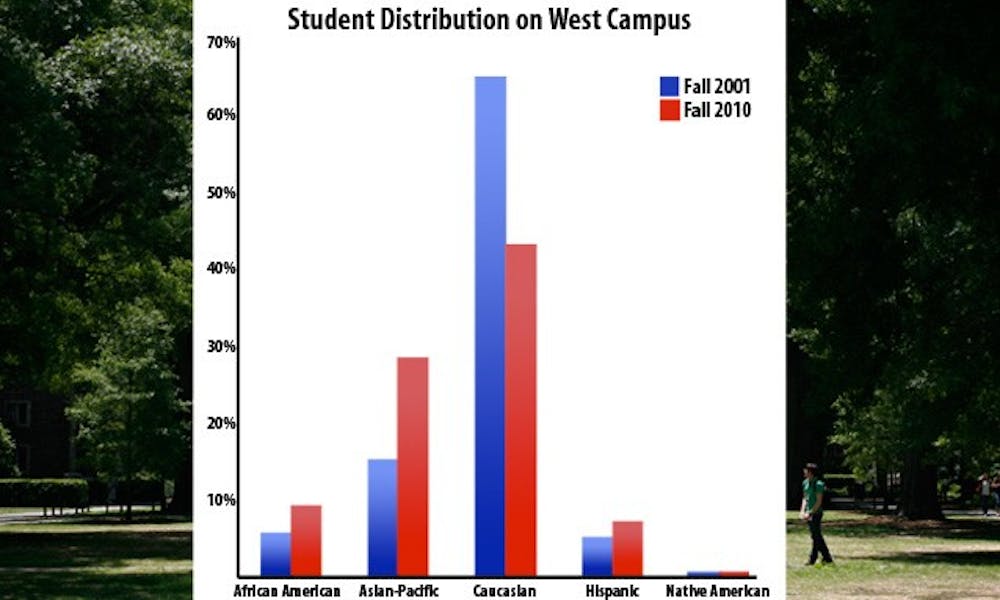As the University prepares to transition to the house model in Fall 2012, administrators and students are examining how the new living structure will affect diversity.
Although West Campus has become more representative of the diversity in the student body since 2002, officials have said changes in the housing model should not decrease this diversity but rather enhance student communities and experience.
“If you just look at the numbers, and you just say how many people of what kind live on West [Campus], it’s not that imbalanced, but if you drill down and say, ‘How are they experiencing the residence experience?’ then there is real disparity,” said Steve Nowicki, dean and vice provost of undergraduate education. “That’s what I talk about with equity—I’m not just interested in numbers. I’m interested in the totality of the experience.”
Since Fall 2001, West Campus has become more racially diverse due to increased enrollment of minority students and broad efforts to ensure that the campus is representative of the larger student body, Vice President for Student Affairs Larry Moneta said. Administrators added that in transitioning to the house model, they are committed to maintaining that diversity.
Nine years ago, black students represented just 5.6 percent of West Campus residents and white students represented 65 percent, according to data provided by Residence Life and Housing Services. Currently, the population of blacks on West has nearly doubled to 9.3 percent, and white students occupy just over 43 percent of beds on the campus. The residential population of Asian-Pacific students has also increased since Fall 2001, from 15.1 to 28.4 percent.
“[The lack of diversity in 2001] won’t happen again because [of] everything else we’re doing on West—promoting houses [and] making the non-selective experience as rich as the selective experience,” Moneta said.
According to the data provided by RLHS, the populations of black, white and Asian-Pacific students living on West mirrors the racial makeup of the overall student population, with black and Asian-Pacific students being the two largest minority groups within the student body. Black and white students represent 10.3 and 45.7 percent of the undergraduate population respectively, and Asian-Pacific students comprise 28.6 percent of the total student body.
One effort that helped to increase residential diversity was requiring all sophomores to live on West beginning in 2002, Moneta said. Because the sophomore class now makes up the majority of West, the campus is more representative of the student body, he added.
But Moneta also said that in switching from the current quadrangle model to a house model, sophomores will no longer be required to live on West. He added, however, that he is not concerned that this will reverse the gains the policy achieved.
Instead, the house model will encourage diversity throughout West by allowing for the continuation of the randomized communities formed on East Campus. Although the administration may institute broad policies to promote diversity, Moneta said officials do not intend to enforce strict or confining regulations on houses.
Student input has also been significant in the development of the house model, Nowicki said. The administration included the Council for Collaborative Action—a committee of leaders from student groups—Campus Council and Duke Student Government in its conversations about the house model.
Campus Council President Stephen Temple, a senior, said it is too soon to know exactly how diversity may be affected by the house model.
“There is certainly the potential for an increased diversity on West versus Central [Campus]— that will depend how things play out as we get more into logistics,” Temple said.
Asian Students Association President John Chang, a senior, said, he feels little anxiety about this residential policy.
“[Residential diversity] in particular is not something our constituency has brought up as a huge problem,” Chang said.
But other student group leaders expressed concerns about how the house model will achieve its goal of improving diversity.
“The housing model does a good job of fostering a good sense of community, which we fully understand and appreciate,” said junior Nana Asante, president of the Black Student Alliance, on behalf of the organization’s executive board. “But what we feel is not being made clear is how this necessarily translates into fostering diversity.”
The responsibility of building diverse communities also falls to students, Asante added.
“If we can’t raise hell about something that we say we want, how is it reasonable to expect [the] administration to do so on our behalf?” she said.
Get The Chronicle straight to your inbox
Signup for our weekly newsletter. Cancel at any time.

